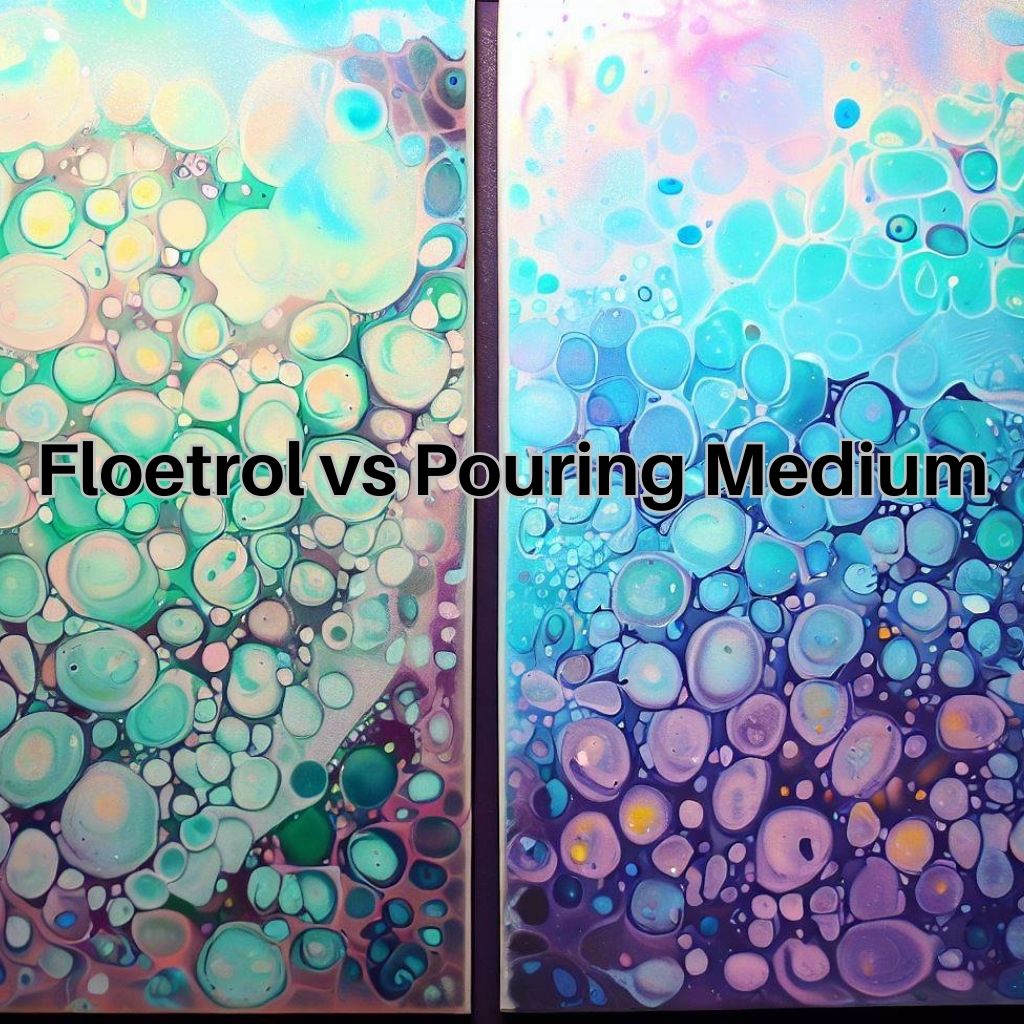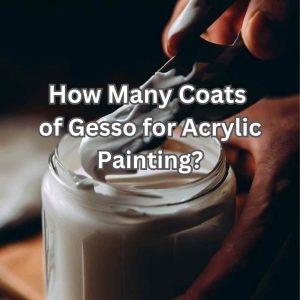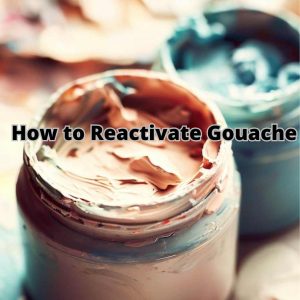When it comes to the world of acrylic pouring and fluid art, there are a plethora of mediums available to artists. Two of the most popular options are Floetrol and pouring medium.
If you’re new to this style of painting, the variety of mediums can be overwhelming. Each medium has its own unique properties and can produce different effects in your artwork. So, how do you know which one to choose for your next masterpiece?
In this article, we’ll take an in-depth look at Floetrol vs pouring medium. We’ll explore the differences in consistency, opacity, cell formation, and drying time between these two mediums.
By the end of this article, you’ll have a better understanding of which medium is best suited for your specific artistic goals.
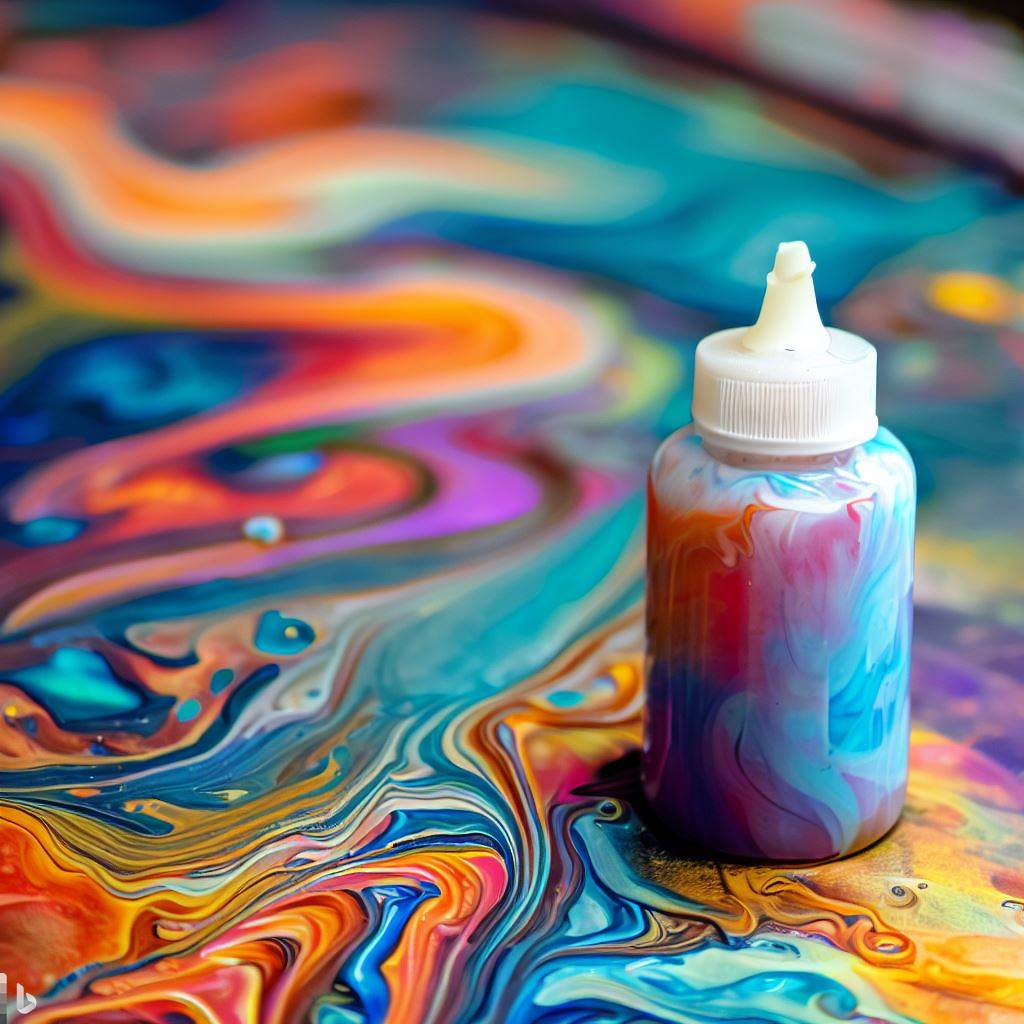
That said, here’s a comparison table for Floetrol and Pouring Medium for your ease of access:
| Properties | Floetrol | Pouring Medium |
| Purpose | Used as a paint additive | Used as a pouring medium |
| Consistency | Thick, viscous liquid | Thin, watery liquid |
| Color | Milky white | Transparent |
| Drying time | Slower drying time | Faster drying time |
| Glossiness | Matte finish | Glossy finish |
| Mixing Ratio | 1:1 with acrylic paint | Varies by brand |
| Levelling | Good leveling properties | May have less leveling |
| Cost-effectiveness | Affordable | Can be more expensive |
| Availability | Widely available | May not be as readily available |
| Application | Can be used in a variety of applications, including faux finishing and house painting | Specifically designed for fluid art and pouring techniques |
Now, let’s explore further to understand their specific properties and uses in acrylic pouring art
What is Floetrol?
Floetrol is a paint additive and conditioner that is commonly used in the art of acrylic pouring. It is a water-based product that is designed to improve the flow and workability of acrylic paints.
Floetrol is manufactured by the Flood Company and is widely available at most hardware stores, art supply stores, and online retailers.
Floetrol is primarily composed of propylene glycol, which is a clear, colourless, and odourless liquid that is commonly used in the production of food, cosmetics, and pharmaceuticals.
Floetrol has several properties that make it an ideal additive for acrylic pouring. It is a milky white liquid that has a slightly thick consistency.
When mixed with acrylic paint, it helps to improve the flow and workability of the paint, making it easier to create smooth, even layers.
Floetrol also helps to reduce the appearance of brush marks and bubbles in the finished painting. Additionally, it can promote the formation of cells, which are round, fluid-filled shapes that add visual interest to an acrylic pour.
What is the Pouring Medium?
Pouring medium is an essential additive used in acrylic pouring techniques to create fluid art. It is a liquid substance that when mixed with acrylic paint, increases the flow and consistency of the paint, making it easier to pour and spread across the canvas.
Pouring medium is usually a combination of water, a binding agent, and a solvent. The binding agent helps the paint adhere to the canvas, while the solvent thins the paint and makes it more fluid.
The properties of the pouring medium vary depending on the brand and type used. Some are formulated to create a glossy finish, while others create a matte finish. The consistency of the medium can also vary, with some being thicker or thinner than others.
Most pouring mediums dry clear and remain flexible, allowing the paint to move and shift without cracking or peeling. They also resist yellowing over time, ensuring the vibrancy of the colours remains intact.
Differences Between Floetrol and Pouring Medium
Now that you have a basic idea about the differences between pouring medium and floetrol, let’s explore further to understand what differences they create in acrylic pouring art-
Consistency
Floetrol is a paint conditioner that is specifically designed to improve the flow and levelling properties of paint. It is a thick, viscous liquid that is added to paint to make it thinner and more workable without changing its consistency.
This means that Floetrol can help to prevent brush marks and roller marks when painting, and it can also help to reduce the appearance of drips and sagging.
Pouring medium, on the other hand, is specifically designed for fluid art and has a thinner consistency than Floetrol. It is a watery liquid that is added to paint to create a more fluid consistency that is ideal for pouring techniques.
Opacity
Floetrol can make the paint more translucent while pouring medium can make the paint more transparent. This is important to consider when choosing between the two mediums, depending on the desired effect.
If you want your paint to be more translucent, then Floetrol is a better choice. If you want your paint to be more transparent, then pouring medium is a better choice.
Cells
Cells are circular or oval shapes that form when one colour of paint is dropped onto another colour of wet paint.
Floetrol tends to create larger, more defined cells in the paint while pouring medium can create smaller, more subtle cells.
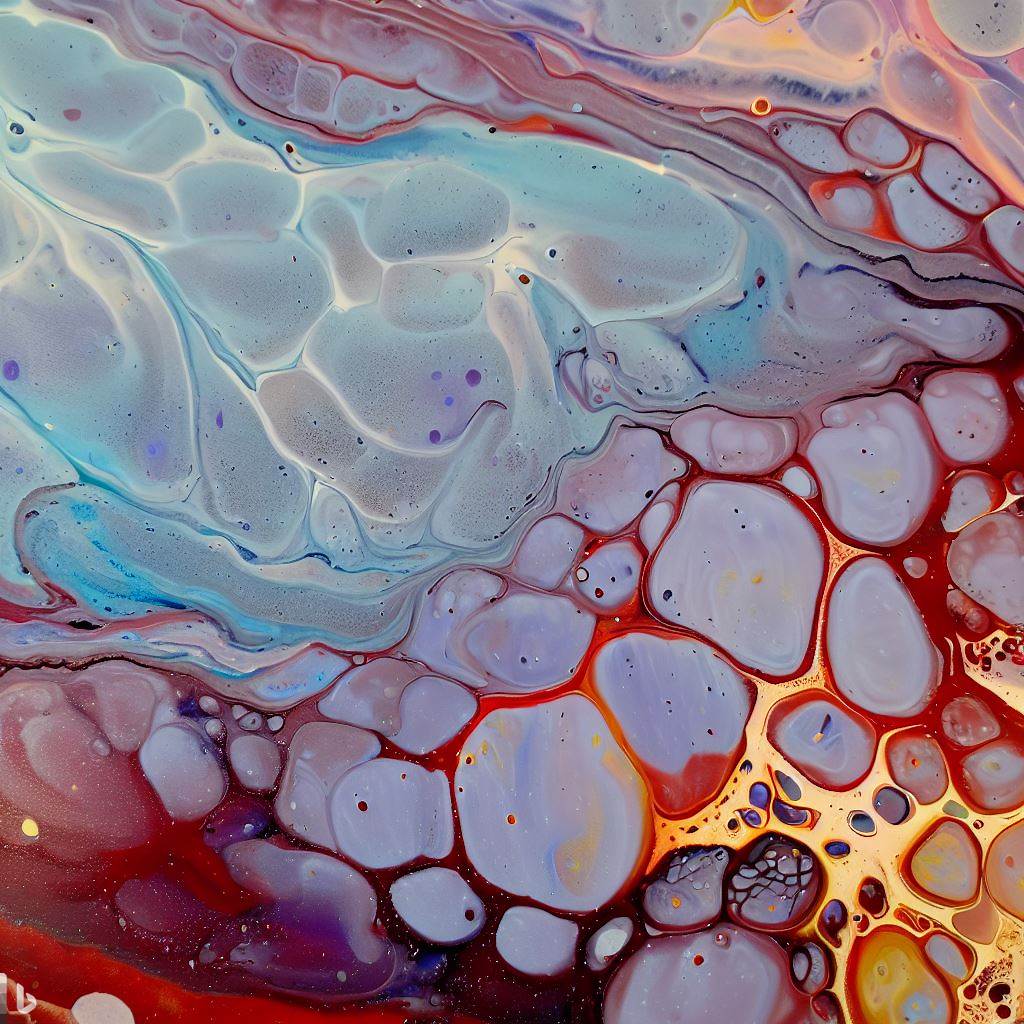
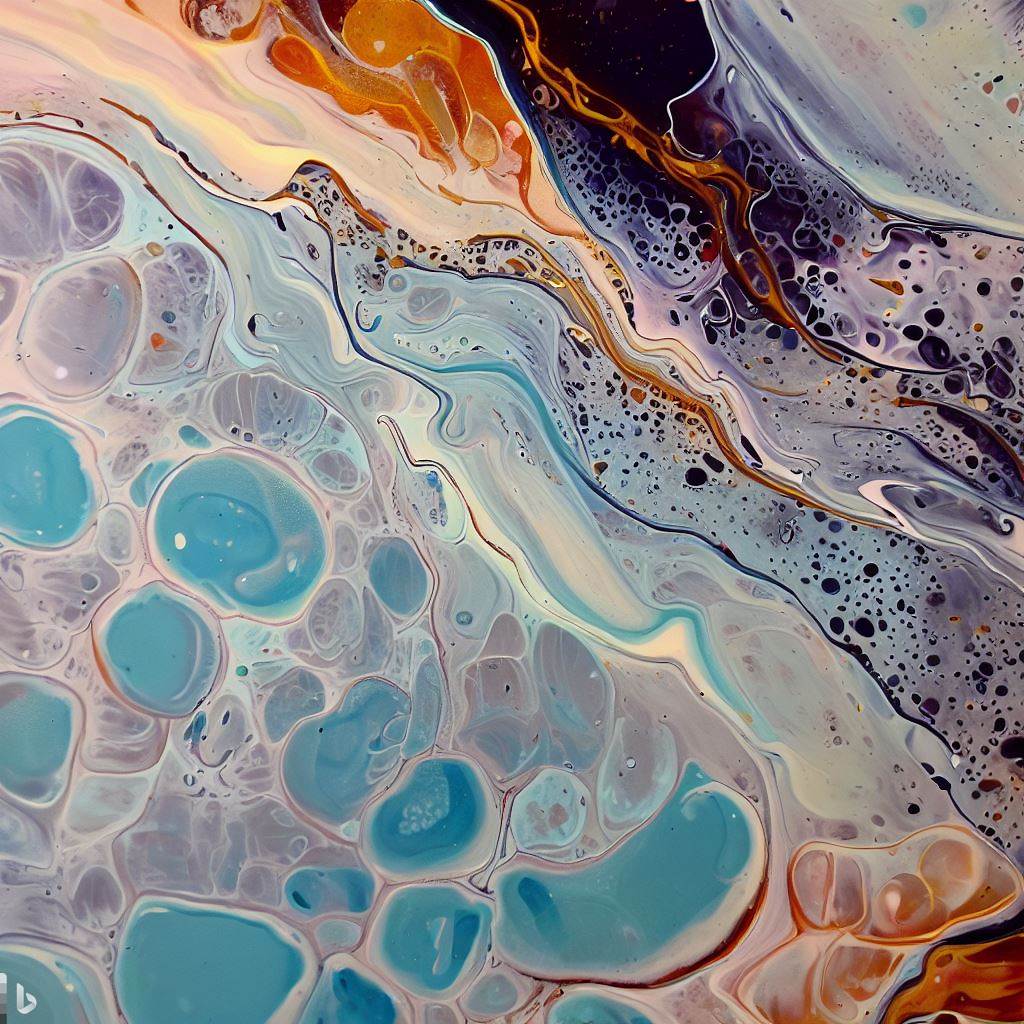
Floetrol
Pouring Medium
However, the size and definition of cells can also depend on other factors such as paint consistency and technique. Some artists prefer larger cells for a more dramatic effect, while others prefer smaller cells for a more subtle effect.
Drying Time
Both Floetrol and the pouring medium can extend the drying time of paint, but they do not significantly affect the drying time of the final artwork.
The drying time of the final artwork can vary depending on the thickness of the paint and the humidity of the environment.
In general, adding Floetrol or pouring medium to paint can extend the drying time of the paint by a few hours to a day. However, this can vary greatly depending on the specific conditions.
For example, if the humidity is high and the paint layer is thick, the drying time may be longer than if the humidity is low and the paint layer is thin. Additionally, the type of paint used can also affect the drying time.
In most cases, it is recommended to wait at least 24 hours before handling or moving a painting that has been treated with Floetrol or pouring medium.
However, it is always a good idea to test a small area with the desired amount of medium and wait for it to dry completely before handling or moving the painting. This will help ensure that the paint adheres properly to the surface and that the final appearance of the artwork is not affected by any residual moisture.
Drying Appearance
Both mediums can affect the final appearance of the dried artwork. Floetrol can create a slightly glossy finish while pouring medium can create a more matte finish.
However, the final appearance can also depend on the type of paint used and the technique used for the pour. Some artists prefer a glossy finish for a more vibrant look, while others prefer a matte finish for a more natural look.
Price
Floetrol is generally less expensive than pouring medium and can be found at most hardware or home improvement stores. It is a popular choice among DIY painters who want to improve the flow and levelling properties of their paint.
Pouring medium, on the other hand, is typically more expensive and can be found at art supply stores or online retailers.
It is a specialized medium that is specifically designed for fluid art and pouring techniques, and it is popular among artists who want to achieve a particular effect or style in their work.
Floetrol vs Pouring Medium: Which One is the Best for Beginners?
When it comes to acrylic pouring, beginners often wonder which medium to use – Floetrol or pouring medium? Both have their own benefits and drawbacks, and it ultimately depends on personal preference and the desired outcome of the artwork.
Floetrol is a popular choice among beginners due to its ease of use and affordability. It is a paint additive that helps to reduce brush marks and increase the flow of paint, making it ideal for creating cells and creating a smooth finish. It can be easily found in hardware stores and online, making it a convenient option for those just starting out.
Pouring medium, on the other hand, is specifically designed for acrylic pouring and is often used by professional artists. It is a more expensive option compared to Floetrol, but it has a higher quality and consistency. Pouring medium helps to create a glossy finish and is ideal for creating a variety of effects such as lacing, feathering, and blending.
Here’s a table summarizing the pros and cons of each:
| Medium | Pros | Cons |
| Floetrol | a. Easy to use b. Affordable c. Reduces brush marks d. Increases the flow of paint | a. May not produce as glossy of a finish b. May not be as consistent as pouring medium c. Can dull the colours and create muddy results d. Can take longer to dry and cure |
| Pouring Medium | a. Specifically designed for acrylic pouring b. Helps to create cells in paintings c. Produces a glossy finish d. Ideal for creating a variety of effects like feathering and veining | a. More expensive b. May require thinning with water or certain effects c. May require more skill to use effectively |
FAQs
- Which medium is better for achieving transparent effects in artwork?
Pouring Medium is known for its ability to enhance transparency in paint, making it an ideal choice for artists seeking captivating, layered, and dimensional effects in their artwork.
- Can I use Floetrol and Pouring Medium together in my artwork?
Absolutely! Many artists explore the possibilities of combining Floetrol and Pouring Medium to achieve a desired balance of viscosity, transparency, and cell formation in their artwork. Experimentation is key to discovering unique effects.
- Do Floetrol and Pouring Medium affect the drying time of paint?
Both Floetrol and Pouring Medium can extend the drying time of paint to some extent, but the exact drying time will still depend on factors such as paint thickness, humidity, and environmental conditions.
- Are Floetrol and Pouring Medium archival and suitable for long-lasting artwork?
Both Floetrol and Pouring Medium are generally considered suitable for archival artwork when used properly. However, it is recommended to follow best practices, such as using quality paints and ensuring the compatibility of mediums with specific paints.
- Can Floetrol or Pouring Medium be used as a varnish or protective coating?
Floetrol and Pouring Medium are not typically used as varnishes or protective coatings for finished artwork. It is recommended to use dedicated varnishes or sealers that are specifically formulated for that purpose to ensure proper protection and preservation of your artwork.
Wrapping Up
After comparing Floetrol vs Pouring Medium, it is clear that both mediums have their benefits and drawbacks.
Floetrol is a more affordable option and can be found easily in most hardware stores. It is also easy to use and produces great results. However, some artists have reported that it can cause cracking in their paintings over time.
Pouring Medium, on the other hand, is specifically designed for acrylic pouring and is less likely to cause cracking. It also has a longer working time, allowing artists to create more intricate designs. However, it is more expensive than Floetrol and can be harder to find in stores.
Ultimately, the choice between Floetrol and Pouring Medium comes down to personal preference and the specific needs of the artist. Both mediums can produce stunning results when used correctly, and it is recommended that artists experiment with both to find the best fit for their individual styles and technique.
If you’re curious about the differences between Floetrol and traditional pouring mediums, you might also be interested in guide on how to make your pouring medium.

